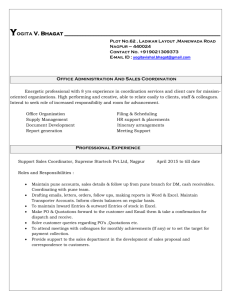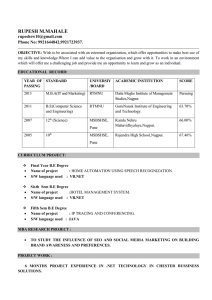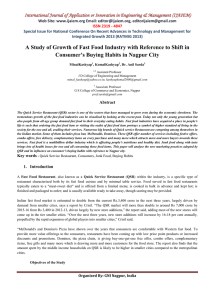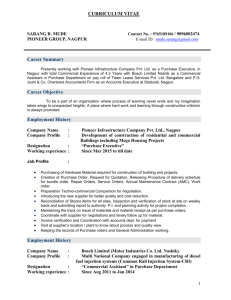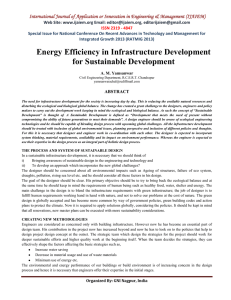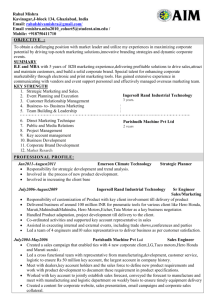International Journal of Application or Innovation in Engineering & Management...
advertisement
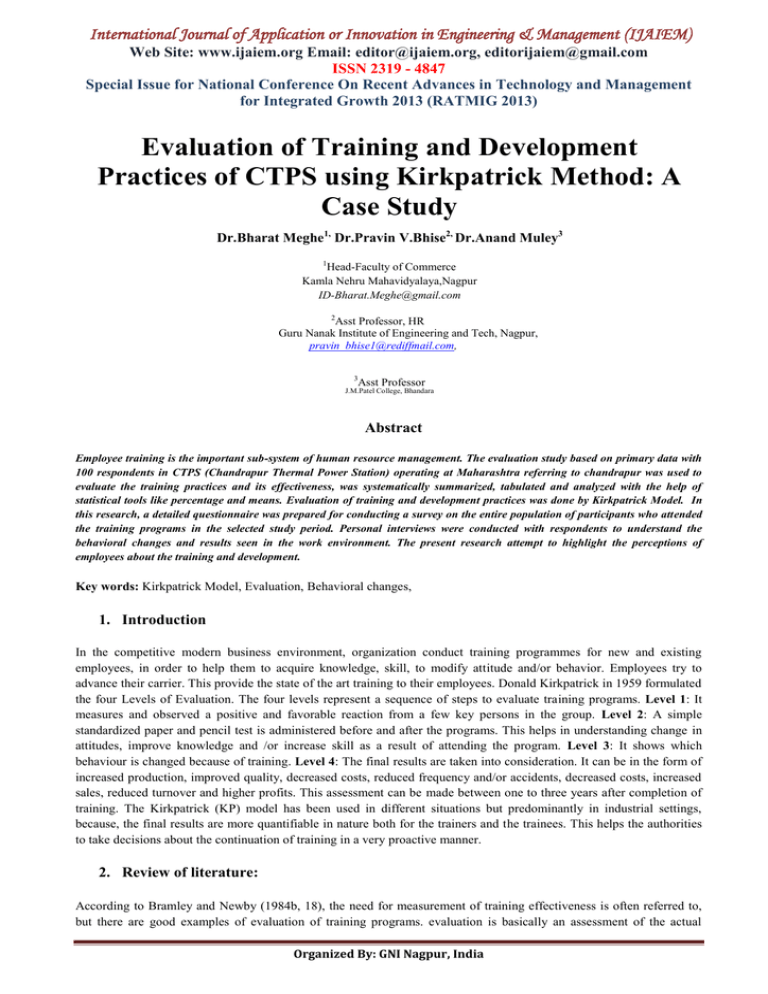
International Journal of Application or Innovation in Engineering & Management (IJAIEM) Web Site: www.ijaiem.org Email: editor@ijaiem.org, editorijaiem@gmail.com ISSN 2319 - 4847 Special Issue for National Conference On Recent Advances in Technology and Management for Integrated Growth 2013 (RATMIG 2013) Evaluation of Training and Development Practices of CTPS using Kirkpatrick Method: A Case Study Dr.Bharat Meghe1, Dr.Pravin V.Bhise2, Dr.Anand Muley3 1 Head-Faculty of Commerce Kamla Nehru Mahavidyalaya,Nagpur ID-Bharat.Meghe@gmail.com 2 Asst Professor, HR Guru Nanak Institute of Engineering and Tech, Nagpur, pravin_bhise1@rediffmail.com, 3 Asst Professor J.M.Patel College, Bhandara Abstract Employee training is the important sub-system of human resource management. The evaluation study based on primary data with 100 respondents in CTPS (Chandrapur Thermal Power Station) operating at Maharashtra referring to chandrapur was used to evaluate the training practices and its effectiveness, was systematically summarized, tabulated and analyzed with the help of statistical tools like percentage and means. Evaluation of training and development practices was done by Kirkpatrick Model. In this research, a detailed questionnaire was prepared for conducting a survey on the entire population of participants who attended the training programs in the selected study period. Personal interviews were conducted with respondents to understand the behavioral changes and results seen in the work environment. The present research attempt to highlight the perceptions of employees about the training and development. Key words: Kirkpatrick Model, Evaluation, Behavioral changes, 1. Introduction In the competitive modern business environment, organization conduct training programmes for new and existing employees, in order to help them to acquire knowledge, skill, to modify attitude and/or behavior. Employees try to advance their carrier. This provide the state of the art training to their employees. Donald Kirkpatrick in 1959 formulated the four Levels of Evaluation. The four levels represent a sequence of steps to evaluate training programs. Level 1: It measures and observed a positive and favorable reaction from a few key persons in the group. Level 2: A simple standardized paper and pencil test is administered before and after the programs. This helps in understanding change in attitudes, improve knowledge and /or increase skill as a result of attending the program. Level 3: It shows which behaviour is changed because of training. Level 4: The final results are taken into consideration. It can be in the form of increased production, improved quality, decreased costs, reduced frequency and/or accidents, decreased costs, increased sales, reduced turnover and higher profits. This assessment can be made between one to three years after completion of training. The Kirkpatrick (KP) model has been used in different situations but predominantly in industrial settings, because, the final results are more quantifiable in nature both for the trainers and the trainees. This helps the authorities to take decisions about the continuation of training in a very proactive manner. 2. Review of literature: According to Bramley and Newby (1984b, 18), the need for measurement of training effectiveness is often referred to, but there are good examples of evaluation of training programs. evaluation is basically an assessment of the actual Organized By: GNI Nagpur, India International Journal of Application or Innovation in Engineering & Management (IJAIEM) Web Site: www.ijaiem.org Email: editor@ijaiem.org, editorijaiem@gmail.com ISSN 2319 - 4847 Special Issue for National Conference On Recent Advances in Technology and Management for Integrated Growth 2013 (RATMIG 2013) training activity (Zenger and Hargis, 1982; Morris, 1984). The choice of method will be depend on some combination of methodological and pragmatic questions, and there is a need to settle for 'sensible' evaluation - one cannot measure the impact of management training on the whole organisation. Bramley & Newby (1984a) summarize the different of terminology used over the past decade, and offer a comprehensive table showing the interrelationships between various concepts of evaluation. Rackham (1974, 454) offers perhaps the most amusing and least academic definition of evaluation, referring to it as a form of training archaeology where one is obsessively digging up the past in a manner unrelated to the future! In the literature reviewed, Williams (1976, 12) defines evaluation as the assessment of value or worth. Harper & Bell (1982, 24) refer to the planned collection, collation and analysis of information to enable judgments about value and worth. However, as Williams (1976, 12) observes, value is a rather vague concept, and this has contributed to the different interpretations of the term evaluation. Some definitions (Goldstein, 1978; Siedman, 1979; Snyder et al, 1980) focus on the determination of program effectiveness. Several definitions emphasise evaluation as a basis on which to determine program improvements (Rackham, 1973; Smith, 1980; Brady, 1983; Morris, 1984; Foxon, 1986; Tyson & Birnbrauer, 1985). The distinction between formative and summative evaluation is not mentioned by most of these writers, but is implicit in their definitions. The literature review confirms the belief of Morris (1984) that evaluation is regarded by most practitioners as desirable in principle, difficult in practice. Objectives of the study: 1. To study the impact and effectiveness of training and development using Kirkpatrick method at CTPS. 2. To examine methods of the training adopted by the CTPS. 3. To understand the perceptions of employees about the training and development activities conducted by CTPS 3. Methodology: This study is mainly based on primary data. Adequate information has been collected through the printed questionnaire served to the employees A primary survey was done using a detailed questionnaire as a tool. The survey helped in establishing an understanding of all the four levels of evaluation – reaction, learning, behavior and results. The survey used the entire population of participants who attended the training programs. Secondary data was collected from the house journals, company records and company website. 1Q: Skill learned through training is useful for your work (Learning) Category Agree Executive Strongly Agree 20 Disagree 5 Partly agree 0 Supervisor Workmen 0 25 16 06 06 0 28 06 20 11` 0 37 Organized By: GNI Nagpur, India Total International Journal of Application or Innovation in Engineering & Management (IJAIEM) Web Site: www.ijaiem.org Email: editor@ijaiem.org, editorijaiem@gmail.com ISSN 2319 - 4847 Special Issue for National Conference On Recent Advances in Technology and Management for Integrated Growth 2013 (RATMIG 2013) 30 25 20 15 10 5 0 Executive Supervisor Workmen Inference: Almost 75% of the employees strongly agree that the training is uses full to their work 27% of the employees are clear. 2Q: Respondents opinion about training programme (Reaction) Scale Very good 120 100 80 60 40 20 0 No. of person 10 Response (%) 13 Good 71 70 Average 9 17 Bad 0 0 Total 90 100 No. of person Response in (%) Inference: From the above graph it is evident that more than half(80%) of the employees agree that people here get an opportunity to develop their skills to do their jobs further it is clear that 13% of the employees partly agreed that people here get an opportunity to develop their skills further to do their jobs. Organized By: GNI Nagpur, India International Journal of Application or Innovation in Engineering & Management (IJAIEM) Web Site: www.ijaiem.org Email: editor@ijaiem.org, editorijaiem@gmail.com ISSN 2319 - 4847 Special Issue for National Conference On Recent Advances in Technology and Management for Integrated Growth 2013 (RATMIG 2013) 3Q: Training programmes gain some information at the same time receive solutions for the problems (Result) Category Strongly Agree Partly Disagree Total Agree agree Executive 17 07 2 0 26 Supervisor 06 16 05 0 27 Workmen 09 24 04 0 37 30 25 20 15 Executive 10 Supervisor 5 Workmen 0 Strongly Agree Agree Partly agree Dis agree Total Inference: From the above table and graph it is evident that majority of the employees agreed that training programmes of the organization helps to gain some information and at the same time receive solutions for the problems. Further it is clear that. 04Q: Training sessions are helpful for changing behavior of the employees. (Behaviour) Category Strongly Agree Partly Disagree Total Agree agree Executive 13 08 03 o 25 Supervisor 06 23 02 0 30 Workmen 07 19 09 0 35 30 25 20 15 10 5 0 Executive Supervisor Workmen Inference: From the above table and graph evident it is clear more than half (57%) of the employees agreed that training sessions are helpful for narrowing the gap between the management and employees further it is clear that 20% of the employees partly agreed training sessions are helpful for narrowing the gap between the management and employees. 05Q: Training helps to increase decision-making ability (Skill/knowledge enhancement) Organized By: GNI Nagpur, India International Journal of Application or Innovation in Engineering & Management (IJAIEM) Web Site: www.ijaiem.org Email: editor@ijaiem.org, editorijaiem@gmail.com ISSN 2319 - 4847 Special Issue for National Conference On Recent Advances in Technology and Management for Integrated Growth 2013 (RATMIG 2013) Category Executive Strongly Agree 18 Agree Supervisor 18 06 Workmen 06 10 06 Partly agree 1 Disagree Total 0 25 04 0 28 21 0 37 30 20 10 Executive 0 Supervisor Workmen Inference: From the above table and graph it is evident that more than half (75%) of the employees agreed that training is helpful to increase decision making ability. Further it is clear. Findings: 1. 74% of employees agreed that employees are guided to upgrade their technical knowledge & skills through training. (Learning) 2. 84% of employees responded good for training programme (Reaction) 3. 77% employees pointed out that training programmes provide valuable information and also helpful for solutions for the problems(Result) 4. 64% of employees opinioned that training sessions are helpful for changing behavior of the employees.(Behaviour) 5. 57% says training helps to increase decision-making 4. Conclusions and Suggestions: Overall evaluation factor indicates that 84% of the respondents have express happiness about the training programmes conducted by CTPS.. The employees are satisfied by the support given by the management to improve the employees skills. Employees agreed that the objectives of the training courses are clear. The trainers who conduct the training programs are qualified and experienced. It was interesting to note that through the study, the respondents came up with the same kind of suggestions for evaluation as suggested under the KP model. Training should be more of on-jobtraining live but not off the job. More technical trainings required. Employee should attend the training porgrammes seriously and should not feel training is burden. The Head of the department should explain on the training programmes. References [1] Kirkpatrick, L. D. and Kirkpatrick, D. J. Evaluating Training Programs – The Four Levels, Benett Koehler Publishers Inc, December 2005 [2] Saxena, R.N. Impact Evaluation of Personal Growth Training: A Quasi-experimental Organized By: GNI Nagpur, India International Journal of Application or Innovation in Engineering & Management (IJAIEM) Web Site: www.ijaiem.org Email: editor@ijaiem.org, editorijaiem@gmail.com ISSN 2319 - 4847 Special Issue for National Conference On Recent Advances in Technology and Management for Integrated Growth 2013 (RATMIG 2013) [3] Reay, D.G. Evaluating Training, Kogan Page, London, 1994H.H. Crokell, “Specialization and International Competitiveness,” in Managing the Multinational Subsidiary, H. Etemad and L. S, Sulude (eds.), Croom-Helm, London, 1986. (book chapter style) [4] Phillips, J. and Stone, R. D. How to measure training results: A practical guide to tracking Spitzer, D. R. Embracing Evaluation Training, Training, Vol.36(6), 1999, pp. 42-47. [5] Raju T. Dr: Training as an effective HRD Technique in banking Sector-An Opinion Survey, IJTD Journal XXV: 2, April-June, 2005, pp. 67-75. | 31. Ramasubramanian [6] Rani Geetha Priyadarshini R and Venkatapathy R: Performance and HRD: A study among. AUTHOR Dr. Bharat Meghe is a Doctorate in Business Economics from RTM Nagpur University and a post graduate in commerce from Nagpur University. He is presently associate professor and Head Faculty of Commerce in Kamla Nehru Mahavidyalaya, Nagpur He has over 28 years of teaching experience in under graduation & 20 years in post graduation. He has having 12 years of research experience He is a supervisor for Ph.D. degree for the subject commerce and management under the faculty of Commerce and awarded PhD to the 23 students under his supervisor till date. He has published books on Business Economics for B.Com I (Pimplapure publication) Statistical Techniques for B. Com.I (2012), Financial Accounting for B.Com.III. ( Datta Publication), Business Law for Com III Award and Recognition -Mahatma Fule Talent Research Acadamy‟s Dr. Panjabrao Deshmukh Educational National Award 2011¸Nagpur University`s Best Teacher Award, 2010-11,Maharashtra Government has given „Adasrha Shikshak Puraskar, 2009-2010 (Maharashtra Govt. Ideal Teacher Award 2009) National Human Welfare Award Dec 2008,Sanmanpatra given on World Human Rights Day, Dec 2009 by Maharashtra Labour Welfare Board, Membership – Academic Member board of Studies In Business Economics, faculty of Commerce ,Member of Senate, Rashtrasant Tukadoji Maharaj Nagpur University ,Ex- Chairman, Board of Studies in Business Economics, Nagpur University, Member Board Of Studies Account and Statistics, S G B Amravati university, Member Ordinance Committee Faculty of Commerce RTM Nagpur University, Member Equivalence Committee Faculty of Commerce, RTM Nagpur University, Member Research Recognition Committee in Business Economics¸ Member, Faculty of Commerce, Nagpur University, Member of Standing Committee, Nagpur University, Member, Academic Council, Nagpur University, Invited Member, Board of Studies Insurance and transport, Pune University, Pune Member of Committee for the appointment of Lecturer Expert on selection committee of affiliated colleges, Member BUTR constituted a committee for preparing the norms for the recognition of P G Teacher for Post Graduate and M Phil Course, Members of U/S 32 (5) Committee¸ Member of BCUD Committee RTM Nagpur University, Nagpur, Member of Board of Examination, RTM Nagpur University, Nagpur. Dr. Pravin Bhise received the Doctorial degrees in management from RTMNU, Nagpur in 2012. He currently working with Guru Nanak Institute of Engineering & Technology, Dept of Management Studies, Nagpur as Asst. Professor. He is having 8 years of teaching and 7 years of industry experience. He has presented research papers in National / International Seminars/ Conferences. Article published in the newspaper “The Hitwad” on “New face of HR practices and emerging Challenges”, “Emotional Intelligence: A way to success”, “Ethical issues in Advertising & Social Responsibilities”, “Post seperation:Kabhi Alvida Na Kahna For HR”, “Carrier in Mechanical Engineering”. Dr. Anand Muley is working as Assistant Professor in J M Patel College of Arts, Commerce & Science, Bhandara. Prior to this worked with many institution for 7 years. Completed M.B.A, M.Com, Ph.D. Has presented 7 National, 6 International papers. Organized By: GNI Nagpur, India
